
Treating Sprains and luxations Page Menu: 1 2 3 4 5 6 7 8 9 10 11 12 13 Next>>
Treating Sprains & Dislocations in the Golden Age of Piracy, Page 1
"Would you be a Sea Chirurgeon; Then it is necessary you should understand, first, how to fit your self out for the Sea, in order to which, you are first to consider what those Accidents and Distempers are, that are most incident to the Sea, that you may provide Medicines and Instruments proper for them.
They are these that follow,
All manner of Wounds, especially by Gunshot, Bruises or Contusions, both outward and inward; Spreins, Dislocations, and Ruptures, Scalding and Burning, especially with Pouder; Pains, Aches, and Numbness of Limbs, Tumours, Ulcers, and Gangrenes, Ophalmias [inflammation of the eyes], Squinzys [an acute inflammation of the soft palate around the tonsils], Hemorrhage at the Nose, Tooth-ach, Piles [hemorrhoids], Procedentia Ani [rectal prolapse]." (John Moyle, Chirurgus Marinus, 1693, p. 1)
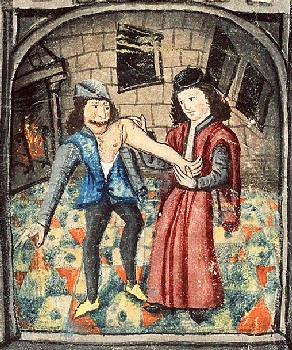
Setting a Dislocated Arm, From La grande chirurgie,
By Guy of Chauliac c. 1450
Fixing sprains and setting and repairing dislocations or luxations were an important part of a sea surgeon's work according to John Moyle, one of the few sea surgeons writing during the Golden Age of Piracy. Although we can't say his list was created in order of the importance of health problems, it would seem to be so given that it starts with gunshots, bruises and contusions and ends with nose bleeds, tooth aches and rectal prolapse. If so, sprains and dislocations rate third and fourth, perhaps at least hinting at how common such wounds were. This should not be surprising given that sailors were frequently climbing up into the masts and down into the hold, walking and running across water-slicked wooden decks and hauling anchors and lines across that deck. Slips and falls must have been common occurrences, sometimes resulting in fractures, sprains and dislocations.
Sprains will be discussed first, althought they were given only slight notice by many of the period surgeons in their books. Dislocations (also called luxations) make up the bulk of the article. Nearly all surgeons discuss dislocations in their books, beginning with their general treatment then going into more detail on how a surgeon should handle the dislocation of individual parts. Most authors discuss the more common types of dislocations such as shoulders, elbows and knees; only some of them go into treating more obscure luxations such as the spine, skull and palm of the hand. Although a large number of such obscure dislocations were discussed, this article will focus on those mentioned by sea surgeons, leaving treatment of the less likely dislocations for the curious reader to explore on their own. The article finishes with a brief discussion of medical complications which could accompany a luxation and how they were handled.
Treating Sprains
By definition, sprains are "a violent contortion or wresting of the Tendons of the Muscles, occasioned by some sudden Accident"1 and do not involve true dislocation of the bones. This may
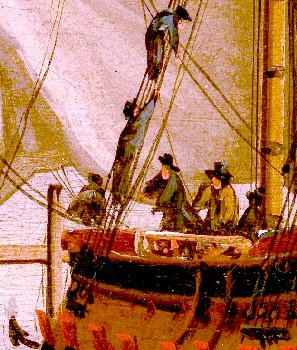
Artist: Peter Monamy
Sailors Working, From Shipping in a Calm (1710-1725)
explain why two of the men used extensively in this article - French surgeon Ambroise Paré and English surgeon Richard Wiseman - spend no time discussing the individual treatment of sprains. Paré points out that when bones get jostled or "lightly moved ...we only cal them subluxations or strains"2, but gives them little more attention. This lack of interest in sprains may have been at least in part because such wounds would usually heal without treatment over time.
Sea surgeons had a greater need to treat such wounds, however. Merchant ships in particular did not have the manpower (or typically the space) to allow a man to spend a lot of time convalescing. So anything that could be done by the surgeon to speed recovery of a wounded man was important.
Navy surgeon John Atkins starts by explaining that dislocations are always accompanied by sprains, from "whence the Symptoms of Pain, Tumor, &c. [occur] and oftentimes without it."3 Atkins' points out that the acuteness of the pain felt is dependent on the sensitivity of the joint wounded and the tendons located there, noting that the "more solid it is, the longer Time it must take for Restitution."4 He goes on to tie the problems of healing to humor theory noting that the sensitivity of the joints "stimulate an Afflux of the nervous Juice and Humours to the Part which promotes those additional Accidents [complications] that obstruct it"5. While humors do figure into sprains, most of the work to relieve a sprain has little to do with them.
Several sea surgeons recommend ways to treat sprains, primarily involving topical medicines, supporting the sprained joint and rest.
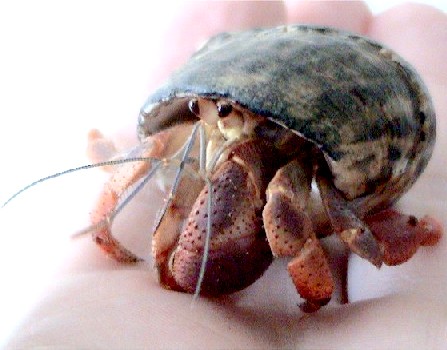
Photo: LA Dawson - Caribbean hermit Crab (Coenobita clypeatus) Although he doesn't talk much about medicine in his book, buccaneer surgeon Lionel Wafer thought enough of the problem of sprains to recommend a remedy. He explained that there was "Insect like a Snail in great plenty among the Samballoe’s [San Blas Islands, Panama], which is call’d the Soldier-Insect [a type of hermit crab according to editor George Parker Winship]."19
In his first book on sea surgery, surgeon John Moyle combines sprains with contusions, recommending that they receive same treatment. He tells the surgeon to rub the wounded area "Hot, and often with Oyl of Hypericon [Oil of St. John's wort], andThe Oil of these Insects is a most Soveraign Remedy for any Sprain or Contusion. I have found it so, as many others have done frequently: The Indians use it that way very successfully, and many of the Privateers in the West-Indies: And our Men sought them as much for the Oil, as for the sake of eating them. The Oil is of a yellow Colour, like Wax, but of the Consistency of Palm-Oil.20
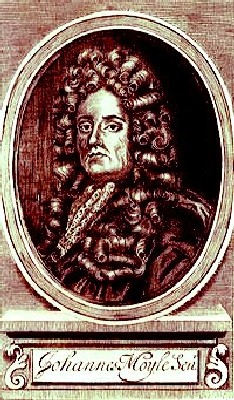
Author John Moyle (1693)
[apply] a Paracelsus [Plaster], or Opodeldoch Plaister."6 He may not have been too far off the mark; Oil of St. John's wort is still considered a folk remedy for superficial wounds, scars and burns.7 Paracelsus' Plaster was used for centuries as a cure for wounds and method for relieving the pain they caused; the Opodeldoch Plaster is based on the Paracelsus plaster.8
Moyle further suggested that the surgeon "Bathe and stuff the part well and hot (likewise) with spiritus vini communis [common spirit of wine], let this be done often, and let your hot Oyl and Emplaster be not only once a day (as is usual) but if you mean to save a mans Life or Limb, let them be often apply'd."9 Moyle finishes this discussion by recommending "let the sprained joynt be still embrocated with Oleum excestrense [oil of Exeter], or Hypericon, and an Oxicrocium Seercloth [cerecloth - waxed cloth] apply'd warm about it."10
In his next book, Moyle gives even more attention to sprains, removing the Opodeldoch Plaister, spirit vini and cerecloth and greatly simplifying his recommendations. He added a new plaster which is made from various other plasters and ingredients: "Rx Emplastrum Paracelsus {1 ounce} [Emplastrum] Diapalma {1 ounce}, Pulv. Croci [powdered saffron] {1 scruple}, Ol. Ros. [oil of roses] q.f. [as much as is needed] misce. f. Emplaster [mix into a plaster]."11 Moyle further suggested a medicine of his own creation which can be used in place of these called Cataplasma Resolvens which he says is used "To mollifie [soften], discuss [disperse gathered humors], and ease pain."12 It was to be applied "warm and often, and you will need no other Medicine."13
Moyle elsewhere in this book suggests a laundry list of medicines which can be applied to "Spreins, Contusions, Fractures, Ruptures, Luxations, stiffness of Sinews, Aches, &c."14 These
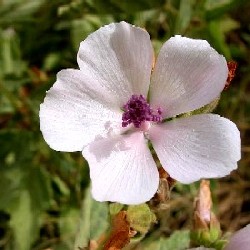
Photo: Pablo Alberto Salguero Quiles
Marshmallow Flower
medicines include those already mentioned along with Oil of Exeter, Oxicrocium, Nerve Ointment, Soldier's Ointment, Emplastrum Catagmaticum and Rupture Plaster. However, this recommendation has a scattershot feel to it with many of the medicines recommended seeming to be targeted at specific complications rather than the sprain itself. For example, the Catagmaticum plaster is specifically noted to be good for healing fractures while the use of the nerve ointment and rupture plaster are clear from their names.
In a more general recommendation, sea surgeon John Woodall explained that the Soldier's Ointment [Unguentum Martiatium] was useful for "cold causes in the head sinewes, and joynts"15 which makes it interesting the Moyle didn't recommend it in his explanation of treating sprains. Woodall does not address sprains directly although, like soldier's ointment, he mentions that some medicines are helpful in relieving and healing them. For example, Woodall suggests that Unguentum Aragon was a useful ointment for "paines of the joynts"16. He also recommends Unguentum Dialthaea Compositum (Ointment of Marsh mallows) as "good against stiffness & paines of the joints in the Scurvy"17 and Honey of Roses combined with aqua vita as "very good to cure wounds in joints where the joint water gleeteth [discharges] out."18
Where Moyle says to apply his medicines hot, fellow sea surgeon Atkins recommends the opposite, advising that nothing can "restore the Nerves and Tendons to a due Tensity again... in my Opinion... by the immediate Use of the Cold Bath, a Means that will restore them to their proper Springiness and Stiffness, (if continued,) and recover Strength sooner than all others, in a much longer Time, could do."21 Current research shows that cold treatment reduces inflammation in wounds by decreasing blood flow when
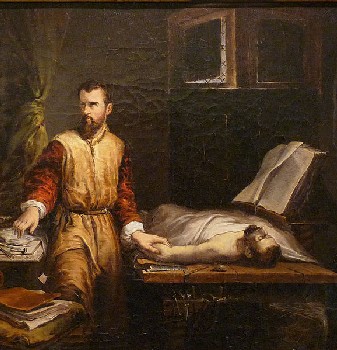
Artist: James Bertrand (19th c.)
applied within 48 hours of the damage. Hot treatment increases blood flow which can help muscles to relax. Based on this both treatments have validity and "alternating heat and cold may help reduce exercise-induced muscle pain."22
Sea surgeon Atkins mentions the medicines used in sprains, but only in passing. He suggests the use of 'Corroboratives' which are medicines recommended to strengthen a part. He includes the use of corroborative plasters, but he also notes that "Rowling [supporting the joint with roller bandages], or Bracing [using wooden splints, pasteboard or tin], may bring up the Rear and have their Use."23 Moyle similarly suggested support in one type of sprain, noting that "if the Wrist [is sprained] tye it up in a Sash. For should you not observe this, the Humors would fall and hinder your Cure."24
Hippocrates recommended bandaging sprains, explaining that "the head of the bandage should be placed on the wound, and there the greatest pressure should be made; the least at the extremities, and intermediately in the middle; the last folds of the bandage should be placed at the upper part of the body."25 Although he doesn't frame it in terms of humors, he does note that the purpose of this bandaging is to 'expel' blood from the wound to prevent complications.
Moyle has the most to say about treating treating sprains and he offers a couple of suggestions beyond medicines. The first is the often-used letting of blood. He includes both scarification - making incisions at or near the wound site to allow blood to flow from it - and phlebotomy - letting of blood by opening a vein.26 Both of these methods are designed to prevent the humors (blood being one of the four humors) from becoming corrupted at the wound site. Moyle also recommends that sprained ankles be kept idle and propped "up resting on a pillow"27. This is again with the desire to prevent blood from flowing to the part, although it obviously would give the muscles time to heal as well. He also advises giving the patient a wound drink28, which is a vulnerary or wound-healing drink often containing wine.29
1 Edward Phillips, "Sprain", The new world of words, 6th edition, 1706, not paginated; 2 Ambroise Paré, The Workes of that Famous Chirurgion Ambrose Parey, 1649, p.380; 3 John Atkins, The Navy Surgeon, 1742, p. 116; 4,5 Atkins, p. 117; 6 John Moyle, Abstractum Chirurgæ Marinæ, 1686, p. 61; 7 C.M. Schempp, R. Lüdtke, B. Winghofer & JC Simon, "Effect of topical application of Hypericum perforatum extract (St. John's wort) on skin sensitivity to solar simulated radiation.", Photodermatol Photoimmunol Photomed., Jun, 2000, 16(3), 125-8; 8 C.C.B., "Opodeldoch", Notes and Queries: For Readers and Writers, Collectors and Librarians, Vol 9, Jan. - Jun. 1902, p. 166; 9 Moyle, Abstractum, p. 62; 10 Moyle, Abstractum, p. 62; 11 John Moyle, Chirugius Marinus: Or, The Sea Chirurgeon, 1693, p. 101; 12 Moyle, Chirugius Marinus, p. 21; 13 Moyle, Chirugius Marinus, p. 101; 14 Moyle, Chirugius Marinus, p. 19; 15,16 John Woodall, the surgions mate, 1617, p. 52; 17 Woodall, p. 49; 18 Woodall, p. 80;19 Lionel Wafer, A New Voyage and Description of the Isthmus of America, 1903, p. 114; 20 Wafer, p. 115; 21 Atkins, p. 117; 22 Yvette Brazier, "Heat and cold treatment: Which is best?", Medical News Today Website, gathered 8/31/17; 23 Atkins, p. 117; 24 Moyle, Chirugius Marinus, p. 102; 25 Hippocrates, On the Surgery, Hippocratic Writings, Translated by Francis Adams, 1952, p. 74; 26 Moyle, Chirugius Marinus, p. 61; 27 Moyle, Abstractum, p. 61; 28 Moyle, Chirugius Marinus, p. 61; 29 For several such wound drinks see Felix Wartz, The Surgeons Guid: Or Military and Domestique Surgery, 1658. p. 330-4

